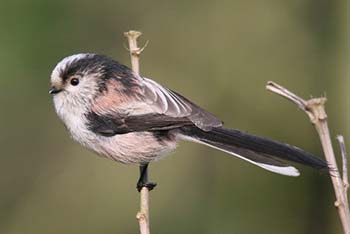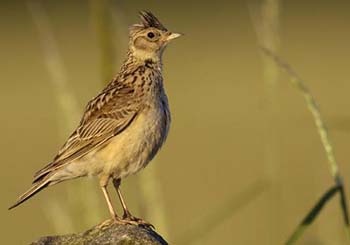Last Thursday my wife and I took a drive out, initially to Maiden Castle, Britain’s largest iron-age hill-fort (a new-build from 600BC, if you don’t count the Neolithic causewayed camp it replaced), but then to Radpole Lake, one of the largest reedbed habitats in the country.
 At the lake we were lucky to catch close sight of a pair of these birds – a long-held ambition – which my wife correctly identified as bearded tits, though they are in fact neither bearded nor tits. There are only about 630 pairs in the country, so it was worth the trip, as was a sight of the rare mediterranean gulls being shooed away by ignorant picnickers in the car-park.
At the lake we were lucky to catch close sight of a pair of these birds – a long-held ambition – which my wife correctly identified as bearded tits, though they are in fact neither bearded nor tits. There are only about 630 pairs in the country, so it was worth the trip, as was a sight of the rare mediterranean gulls being shooed away by ignorant picnickers in the car-park.
 Any fool could have seen that our reed bird male was not bearded, but the owner of rather Prussian mutton chops. Yet the old appellation “tit” makes sense from their resemblance to this, the long-tailed tit. But I had a vague remembrance that this taxonomy has been updated, and at home I found that, some years ago, they’d been reclassified with the Asian parrotbills (like this).
Any fool could have seen that our reed bird male was not bearded, but the owner of rather Prussian mutton chops. Yet the old appellation “tit” makes sense from their resemblance to this, the long-tailed tit. But I had a vague remembrance that this taxonomy has been updated, and at home I found that, some years ago, they’d been reclassified with the Asian parrotbills (like this). 
However, my book says that, on genetic grounds, they’re actually most closely related to the larks. Even that is now outdated, for as the links here and here show, the non-commitally renamed “bearded reedling” (still not “mustachioed” – perhaps it’s the genes that have the beard) is finally concluded to be in a taxon all its own.
Now this fruitless search for family connections reminded me of the rather over-used Dobzhansky dictum that “Nothing in biology makes sense except in the light of evolution.” In fact that quote, in context, has a lot more to do with a theological  justification of evolution than the science. But if all evolution teaches ornithologists, after much labour, is that my reedlings are more related genetically to the ground-nesting, high-altitude singing skylark (of which there were flocks in Maiden Castle to lift the wintry heart) than to other reedbed acrobats, what have we actually learned that’s useful? And I got to wondering if future generations might not so much be asking why evolution was controversial in our time, as why we were so concerned with family trees anyway.
justification of evolution than the science. But if all evolution teaches ornithologists, after much labour, is that my reedlings are more related genetically to the ground-nesting, high-altitude singing skylark (of which there were flocks in Maiden Castle to lift the wintry heart) than to other reedbed acrobats, what have we actually learned that’s useful? And I got to wondering if future generations might not so much be asking why evolution was controversial in our time, as why we were so concerned with family trees anyway.
I spent several years on extensive genealogy research a decade or so ago, and very interesting it was to me emotionally and as social history. But convivial as was the reunion I organized, in a Manchester pub, of Garvey lines that had diverged 150 years ago, there was actually precious little we had in common. Apart from my own family history the Christian faith, too, has a lot to say about bloodlines, be that the descent of Jesus from King David or the hereditary Levitical priesthood (whose Y chromosome appears to be preserved still in the Cohen line, according to the geneticists), so I’m not inclined to dismiss genealogy as irrelevant. But nevertheless, nowadays it is one of the less significant factors in serious study of the human condition.
That wasn’t always so: the biblical emphasis on genealogy reflects the importance of birth heritage in tribal societies. When my friend was a medical missionary in Zaire, the biggest initial priority was to assign him to a tribe, without which nobody would know how to interact with him. But even in Britain, bloodline was not too long since the key to social function: bad behaviour revealed bad breeding (and so cast doubt not just on the character, but the legitimacy, if an offender was from a “good” family). In Tudor times your genealogy even determined what you ate and wore. Once, musicianship was gauged by your descent from the sons of Korah. You were a soldier or a Pundit because of your caste. You were a goldsmith because of your hereditary guild. You still get to be the Queen of England because of your ancestry, but that’s about it nowadays.
Now, nobody really considers it anomalous that an academic should be the grandson of a navvy, or that that a President should have an unemployable cousin. If they did, it would be because the socio-economic difference was surprising, not the genetic similarity. If you want to learn about what makes a person tick, you’ll be interested in their life experience and education, not their ancestral bloodline. And if you want to understand what makes society tick you’ll ask how he relates to those around him (or how his role relates to the roles of others).
But as biology inherited the “chain-of-being” thinking of Classical “fixist” taxonomists like Linnaeus, and gave it the temporal dimension of evolution, it seems to have downplayed other relationships that might be just as significant, or perhaps more so. That’s especially true in these days of the recognition of convergent and parallel evolution. It isn’t where you come from, but where you end up, that seems increasingly relevant. My bearded reedlings, apparently, are somewhat orphaned in the avian family tree. But if they were wishing to join a club, would they be more likely to join the Lark Society or the Association of Reed Dwellers? Are they more usefully regarded as disinherited larks, or as assimilated tits?
To pick another example, the close similarities, at both morphological and genetic levels, between placental wolves and the (sadly extinct) marsupial thylocines has long been noted. But I’ll wager that the two species would be more likely to hang out with each other at the Carnivores Club than to seek the social company, respectively, of caribou or kangaroos. As Wikipedia says, such instructive parallels are not uncommon:
Like the tigers and wolves of the Northern Hemisphere, from which it obtained two of its common names, the thylacine was an apex predator. As a marsupial, it was not closely related to these placental mammals, but because of convergent evolution it displayed the same general form and adaptations…
While some forms were unique to each environment, surprisingly similar animals have often emerged in two or three of the separated continents. Examples of these include the litopterns and horses, whose legs are difficult to distinguish; the European sabre-toothed cat (Machairodontinae) and the South American marsupial sabre-tooth (Thylacosmilus); the Tasmanian wolf and the European wolf; likewise marsupial and placental moles, flying squirrels, and (arguably) mice.
Now, clearly discussing the clubability of animals is facetious, but more seriously it would appear to me that one might learn more about biology, as opposed to taxonomy, by concentrating on what it is in an environment or lifestyle that moulds creatures from completely different stock into astonishingly similar forms and behaviours. Do we understand more about nature by speculating if, and how, dolphins evolved from mesonychids or from artiodactyls, or by studying how and why they’re so similar to ichthyosaurs? Do we gain a more fundamental grasp of truth by seeing them as adapted land dwellers or as adopted fish? It depends to which questions you attach greater importance.
A case in point on a TV nature documentary this week. It was about the human “cute response” to appealing animals, which the presenter attributed to the “evolutionary hard-wiring” that makes us respond positively to babies, which generalises to similar appearances in other species. Mentioning evolution there adds nothing – the cute response would still relate to baby-care even if Adam were created from dust in 4004BC.
But more relevant still was his tracing of the evolution of laughter in primates. Chimps and bonobos express pleasure with quite a passable verison of laughter, which becomes progressively less sophisticated in the less-related great apes. And that certainly gives supporting evidence for common descent, but once you’ve established that, so what? Chimps don’t laugh at my jokes. I don’t learn how a bird flies by knowing that wings were front legs a long time ago: is not biology more about flying wings that exist than walking legs that no longer do? Just as it’s actually more important how I interact in my community or my profession than that my distant ancestor was Irish, so I suggest it’s more important, in the scheme of things, how reedlings fit into the wetland ecology now than how they’re phylogenetically related to larks which, to be frank, have little in common with them except bauplan.
In short, speaking as a genealogist, I’m certain that there are good reasons why we are vastly outnumbered by those who don’t see what difference it makes if your fourth great-grandfather made grandfather clocks. Granted, nothing makes sense in life unless we have ancestors and are born, but it’s what happens thereafter that matters more.
On the other hand, as the paper on Dobzhansky shows, evolution has quite a lot of theological significance, if that’s your main interest.




Genealogy per se doesn’t necessarily mean much – population genetics finds it easiest to estimate past events when it uses neutral markers like nearly all those on the Y chromosome. But for humans over the short term, genealogy does connect with cultural things like religion. Sometime when Wesley was still kicking, my Garrison ancestors in the Carolinas and Georgia became devout Methodists (several became Methodist ministers) and they remained such on my line, until my grandfather married an affluent Presbyterian and made the switch in denominations. I find genealogy has a certain interest, but I’m annoyed that none of my recent ancestors (other than my father and grandfather) left us any written record of who there were or what they thought, beyond a particular Christian affiliation.
I watched a PBS show about lions and why they live in female dominated prides unlike so many other solitary cats. After testing several hypotheses and finding them wanting (I got into the program late,) they found that when they mapped the territories of all the prides, the most successful numerically were all centered on stream confluences – sites rich in prey and of course, water. They studied the response of a pride, attack or not, to the roaring of encroaching lions of a different pride. They found that whatever the specific numbers, they would attack intruders if they had at least 2 more in their group than the other group. The inference is that the larger pride can and will defend a desirable territory when a smaller pride can’t, so there is selection for sociality that depends on characteristics of the local environment. I don’t know if that’s the final answer, but Roger would like it. 🙂
pngarrison,
Your point about cultural elements covers part of what I was getting at. Strictly, genealogy has to do with genetic inheritance, but the religious history of your family is a cultural influence (unless one scrapes the barrel by saying that having a religion at all was a sign of a genetic trait, which would also apply to legs and a cardiovascular system).
One of the things the genealogy websites foster, as you’re aware, is the tracing of DNA links – in the case of the Garvey name, being an Anglicized form of at least three separate lines, one can supposedly confirm which branch one is from. But if in researching that I discovered (somehow) that I had a non-Garvey Y chromosome because my great-grandfather was the result of an adulterous fling, or was charitably rescued from an orphanage, all the things that one finds doing the family history – occupations, political and religious affiliations, etc – would remain the same.
The lion example might be an interesting one for Eve Jablonka’s cultural evolution. Lions inherit their genes, true, but also learn from lion culture how to do the job. So is it genetic or cultural? One would want to know the usual limitations on reproduction – for one off-the-cuff example, have lionesses learned to prevent encroaching males eating all the existing cubs? Assuming it’s genetic (bearing in mind one’s never going to identify the exact genes) might actually diminish study of the cultural complexities.
They found that a lone lioness couldn’t effectively protect her cubs, but a pride could – they had wonderful footage of three lionesses looking really ferocious in driving a male away. (It was all threat though – they were careful to not actually attack.)
I would think the level of sociality is largely genetically determined, like the tendency of dogs to socialize with us where wolves don’t. On the other hand I’ve seen it asserted on these programs that a cat won’t hunt unless taught by its mother, and hunting is a pretty basic behavior. I’m sure that if they weren’t fed they would hunt, but ineptly at first. One of my high school friends just posted a video of their cat encountering a mouse and not having a clue what to do.
A clearly behavioural example that occurs to me is those macaque monkeys that learned to bathe in hot springs in icy weather.
Complex behaviours like that are too finely tuned to depend on mutations, and one has to doubt whether there are enough genes in the genome to account for so many behaviours. In their own way animal behaviours are as complex as human ones, though somewhat more stereotyped.
Another bit of interesting genealogy I found recently is a paper on the genetic genealogy of the Samaritans. There are only 4 extended families of them left now – 750 people- but one of the lines is closely related to the Ashkenazi Cohanim (curiously it’s not the priestly family of the Samaritans.) The others are related to other Jewish lines, but I think it will take some more detailed characterization to be sure they are more closely related to the Jews than to other Levant populations. At any rate, it’s pretty likely that the Samaritans are who they claimed to be, descendants of the northern tribes who either escaped being deported by the Assyrians or later returned to the land.
Genetics and the history of the Samaritans
From 2013, an issue of Human Biology on the population genetics of the Jews
Genetics and the history of the Samaritans: Y chromosomal microsatellites and genetic affinity between Samaritans and Cohanim
http://digitalcommons.wayne.edu/cgi/…biol_preprints
ABSTRACT
The Samaritans are a group of some 750 indigenous Middle Eastern people, about half of whom live in Holon, a suburb of Tel Aviv, and the other half near Nablus. The Samaritan population is believed to have numbered more than a million in late Roman times, but less than 150 in 1917. The ancestry of the Samaritans has been subject to controversy from late Biblical times to the present. In this study, liquid chromatography electrospray ionization quadrupole ion trap mass spectrometry was used to allelotype 13 Y-chromosomal and 15 autosomal microsatellites in a sample of 12 Samaritans chosen to have as low a level of relationship as possible, and 461 Jews and non-Jews. Estimation of genetic distances between the Samaritans and seven Jewish and three non-Jewish populations from Israel, as well as populations from Africa, Pakistan, Turkey, and Europe, revealed that the Samaritans were closely related to Cohanim. This result supports the position of the Samaritans that they are descendants from the tribes of Israel dating to before the Assyrian exile in 722–720 BCE. In concordance with previously published single nucleotide polymorphism haplotypes, each Samaritan family, with the exception of the Samaritan Cohen lineage, was observed to carry a distinctive Y-chromosome short tandem repeat haplotype that was not more than one mutation removed from the six-marker Cohen modal haplotype.
As a cultural phenomenon, these groups that have maintained a substantial degree of genetic identity over millennia are remarkable. It’s hard to imagine in our culture how, if the community survived at all, it wouldn’t have been diluted by out-crosses, converted outsiders and so on withing a few decades.
That’s to an extent true of the Jews, of course, who have retained their cultural identity whilst being, Cohens excepted, as far as I know very similar to surrounding cultures genetically. But that was to be expected, in that even at the settlement of Canaan there were camp-followers from Egypt, there was intermixing with the Canaanaites and so on: genealogy had to do more with proven lines of descent rather than racial purity, the Samaritans notwithstanding. Even amongst the Jews, the greatest continuity is cultural.
The Jews in general are pretty similar to the groups that surrounded them in Israel, but the different diaspora groups are largely distinct from their surrounding groups and more similar to each other than they are to the groups surrounding them in the diaspora. The Ashkenazis did pick up European R1a and R1b Y chromosomes somewhere on their trek to eastern Europe, probably when converts were common.
I just have to record here my mother’s experience in tracing her family history. She had an elderly (and, I remember, very friendly) relative who had known all the people mother wanted to investigate, and Mum travelled halfway across the country to interview her in a nursing home.
The only reply she got to her questions was, “All I know is I’m descended from Adam and Eve.”
Forgot to mention that I sent this to your nemesis Peter Enns, and he did a blog post on it. 🙂
He no nemesis – I just think he’s too much a product of his culture to critique it adequately.
There are folks on the genealogy sites who ultimately go for that. It appears that it’s a question of how much of results of science can you accommodate in your personal beliefs. There are a lot people over here who will only accept things back to 6000 or 10000 years, but I have encountered people in Europe who will go for Y Adam & mito Eve at 200,000 years, but refuse to even look at evidence for speciation and common descent. Some people can handle any amount of age, but no “macroevolution.”
Whoops, hit the wrong reply button.
The reason I like Enns is that he is perfectly clear that what matters is the incarnation/gospel, and that everything before needs to be viewed through that lens. He seems like a fine representative of what that looks like when lived out. Of course I can only judge by watching his behavior on the blog. I don’t always agree with him on details, but I like his sense of proportion about things.